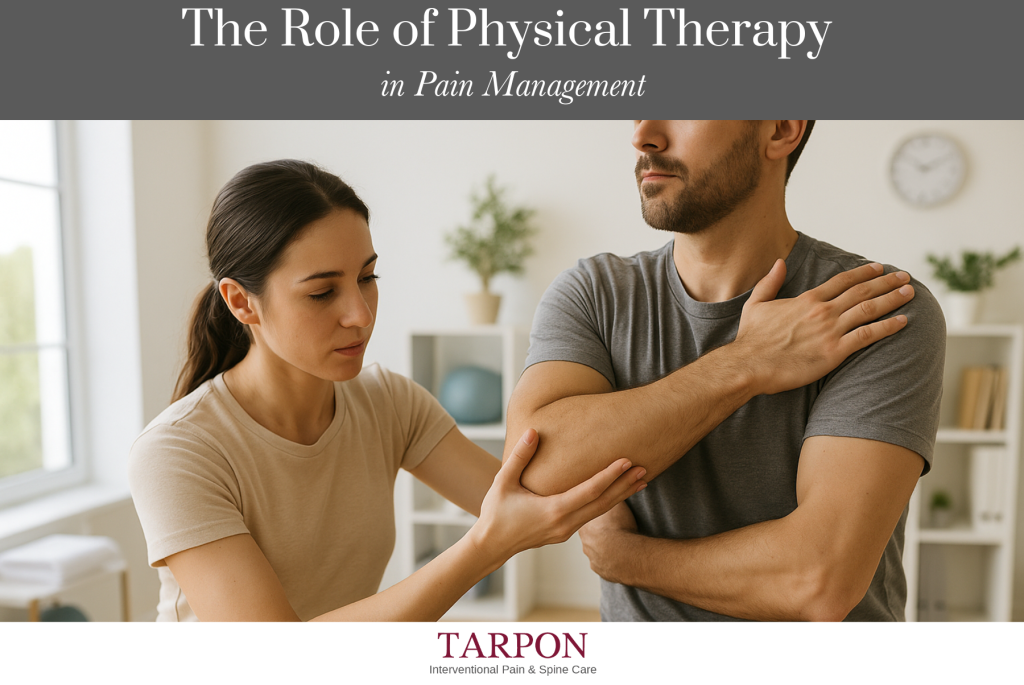
Living with chronic pain can significantly impact your quality of life, making everyday activities feel overwhelming. At Tarpon Interventional Pain & Spine Care, we believe in a multidisciplinary approach to managing pain—one that combines medical treatments with supportive therapies like physical therapy.
Physical therapy goes beyond exercise. It includes guided movement, massage, stretching, and hands-on therapies designed to reduce discomfort, improve mobility, and restore function. When integrated with interventional pain management, physical therapy offers patients a powerful tool for long-term relief.
How Physical Therapy Helps with Pain Management
1. Therapeutic Exercises
Targeted exercises improve strength, flexibility, and posture. These customized routines help reduce the risk of injury and minimize strain on painful areas, especially for conditions like back pain, arthritis, and sciatica.
2. Massage and Manual Therapy
Therapists often use massage techniques, joint mobilization, and soft tissue manipulation to relieve muscle tension, improve blood circulation, and reduce pain signals.
3. Posture and Movement Training
Improper movement patterns can worsen pain. Physical therapy teaches proper posture, gait, and ergonomic adjustments that reduce strain on joints and the spine.
4. Adjunct Modalities
Techniques such as ultrasound, electrical stimulation, or heat/cold therapy may be incorporated to promote healing, reduce inflammation, and improve recovery.
5. Personalized Rehabilitation
After injuries or surgeries, structured therapy programs are critical to regaining independence and preventing future pain episodes.
Benefits of Physical Therapy in Pain Care
- Reduces reliance on medications
- Enhances recovery after injury or surgery
- Improves strength, mobility, and flexibility
- Decreases inflammation and stiffness
- Empowers patients with self-care tools
Q&A: Physical Therapy for Pain Management
Q: Can physical therapy really reduce chronic pain?
A: Yes. By addressing underlying issues such as weak muscles, poor posture, or limited mobility, physical therapy can relieve pressure on painful areas and retrain the body for healthier movement.
Q: How many sessions will I need?
A: The number varies depending on your condition, but many patients notice improvement after just a few weeks of consistent sessions. Your provider will tailor a plan based on your needs.
Q: Is physical therapy safe for older adults?
A: Absolutely. Exercises are adjusted to match your abilities and limitations, making physical therapy safe and effective for seniors dealing with arthritis, balance problems, or age-related pain.
Q: Do I need a referral for physical therapy?
A: Many patients are referred through their pain specialist, but depending on insurance and state regulations, direct access may also be available.
Q: Can physical therapy replace pain medication?
A: While it may not fully replace medications for everyone, it often reduces the need for them. Many patients experience significant relief with physical therapy as part of a broader pain management plan.
Contact Tarpon Interventional Pain & Spine Care
If you are living with chronic pain, don’t wait to find relief. Our team will design a personalized treatment plan that integrates physical therapy with advanced interventional options.
Tarpon Interventional Pain & Spine Care
📍 8080 Independence Pkwy #110
Plano, TX 75025
📞 Phone: (972) 596-1059 Schedule your consultation today!
